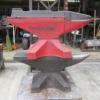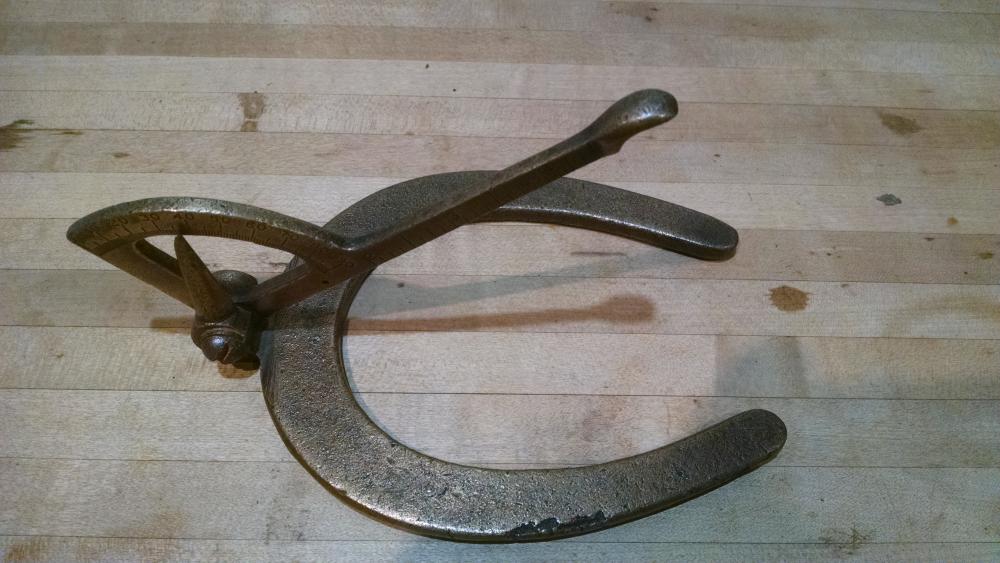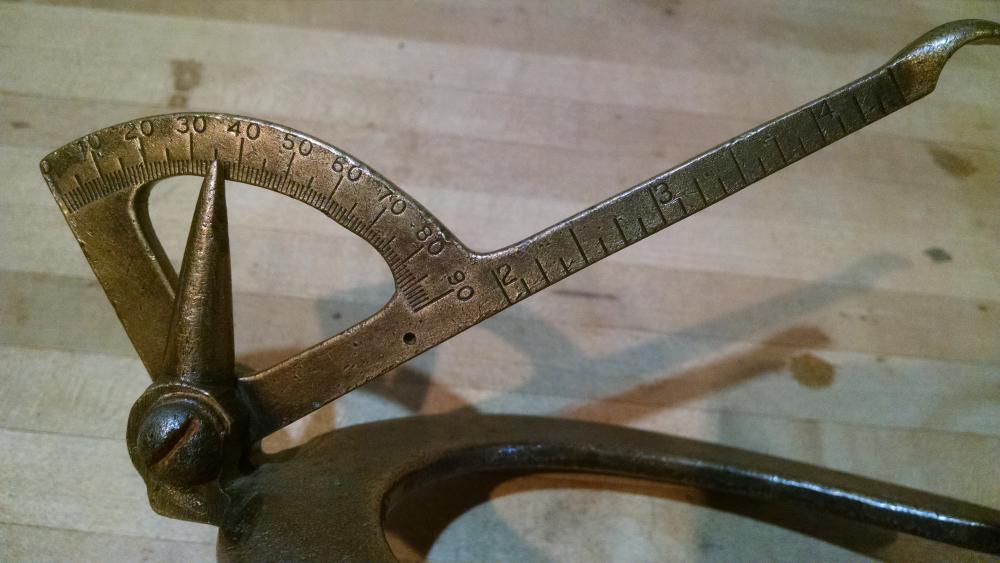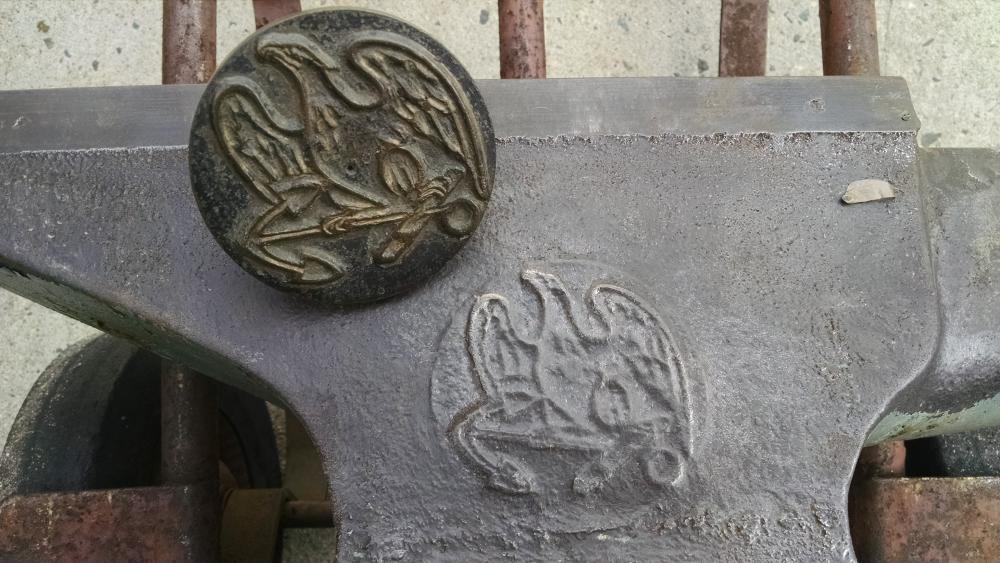-
Posts
2,481 -
Joined
-
Last visited
Content Type
Profiles
Forums
Articles
Gallery
Downloads
Events
Posts posted by njanvilman
-
-
A quick suggestion: try to weld only on clean, ground steel. It looks like the legs were welded over the rust. Cleaning, and grinding the area to be welded will result in better and stronger welds, and they will also look better.
-
Judson Yaggy is correct about the face on the above anvil. It has a steel face probably about 5/16" thick over the cast iron. The anvil is probably a Vulcan with the described markings.
Fisher, and Vulcan on some their anvils, but not all, made the iron under the face wider than the body, both to support the steel and to give the appearance of a thicker faceplate. I also think that this was to serve as an area that could be ground back to reveal a new edge if the present one got damaged.
-
5 hours ago, Frank Turley said:
Yes, it is a hoof gauge or angle gauge used before and after trimming the hoof to check the angle you're seeking. I always carried one like the one pictured. They're made of brass. In my experience shoeing, I found that front feet averaged about 52 degrees. One must be circumspect when measuring however, because some hooves are "dished" (incurved) as viewed from the side. The dish is undesirable, so the shoer must guesstimate where the coffin bone is located within the hoof capsule. The envisioned coffin bone will give a more true measure than does the gauge when applied to the dish.
Are these brass gauges still used or have they been replace by modern nylon or plastic versions? When do you think this one dates from?
And thanks for your information.
-
-
On 11/11/2016 at 9:18 PM, Pac said:
Thanks for the info! I think the plan worked, I believe he changed his mind about selling it for now. After the holidays I will have to contact him again and persuade him to sell me my first Fisher.lol
It is just amazing there is a Fisher in that nice condition out here...
The Fisher & Norris Factory Museum has about a dozen Fisher anvils that are virtually new. Most look like they were never used. I find it amazing too.
-
130 lb Fisher anvil, actual weight heavier(not unusual). There is an Eagle emblem on it. Cast in 1912. Dating done for warranty purposes, guaranteed until the end of 1913.
Well worth the $250. I would buy it for that price.
Any other questions?
-
According to your measurements, the anvil is at least 400 lb, maybe a bit more. The condition of the face is key. It is hard to tell it the edges are good or worn in the photo provided. But know that A&H anvils are considered to be among the best made, and command top $$, if the condition is good.
-
4 hours ago, Pac said:
Just curious to see if age can be determined for this 235lb Fisher I looked at today. The eagle is stamped into the body, 'FISHER' is on left side of front lug, and what looks like a 5 above the rear lug. No other markings found and the face is in great shape. Long story short, the owner might have changed his mind about selling the Fisher for now. Nothing wrong with that because after the holidays I might have another chance at getting my first Fisher...
I have a Fisher anvil that is also marked with just a 5 where the date usually is. I believe these were made in the 1950's, towards the end of the Fisher production. But before Crossley took over and made anvils until 1979.
This anvil was probably sold as a 250 lb. Fisher was never exact in their weights.
If you can get this anvil, it is a lifetime investment, for you, and more generations after. It appear to be unused.
-
Vulcan anvils did not have serial numbers. The 5 is probably just a code for the moldmaker or batch #.
-
11 hours ago, Prentice said:
Ok still new to this. How can I finde out how much my anvil is worth?
10 hours ago, Latticino said:Sell it to someone and see what they will pay for it.
Not to be facetious, but anvil value varies widely dependent on where you live and what the local demand is for blacksmithing tools (or "collectable antiques", unfortunately). There are more rare anvils, and condition matters as well, not to mention how quickly you want to turn it over. If in decent condition list it for under $1 a pound and it will fly out of your hands. You may have to wait a bit if listed for $3 a pond or more, unless it is something special. Some areas are paying up to $5 a pound, but that is typically for a more rare size or type in excellent condition. Don't be fooled by pricing on e-bay.
8 hours ago, Tubalcain2 said:that anvil in middle tn where i live would be in the 450-500 dollar range.
Gentlemen: Please start a new topic on this anvil. This thread is about Fisher anvils. Please do not continue this discussion here. Thank you.
-
-
9 hours ago, Prentice said:
i got all of my dads blacksmith equipment when he passed
i have a big hydraulic press im willing to sell and a 25ld little giant in great condition for the right price
Please start a new thread or post in the Tailgating section. Do not hijack this thread about FISHER anvils with stuff you have for sale.
-
It is NOT a mooring cleat, or a safety Bollard. That is definitely a Bridge anvil. The slots on the bottom are similar to one that got posted here several years ago. It looks like they could slide onto up side down railroad track or heavy I beams to raise it up or make it easier to be moved with a forklift.
-
3 hours ago, Rmartin2 said:
That's about what I figured. Thanks for the input.
If you have the time, and some cash for a possible buy, go to the auction. You never know who will be there, and what interest there will be. Talk to other people that show an interest. That is how I have bought many anvils....from contacts made at auctions.
-
To you, it is worth what you paid for it. To the seller, it was worth what they got for it. As to a future possible sale, what amount of money would it take for someone to buy it from you? That is it value.
-
I would leave the anvil alone and just use it.
Previous owners marks are part of the history of the anvil. Instead of removing them, why don't you add yours with a date. Just stamp them in, do not weld them on.
-
I do not think they are dates. I think they are codes for the pour # and who made the mold. The moldmaker was responsible for the anvil from the mold to when it went to the finishing room for cleaning, grinding, and heat treating. This was Fisher's form of quality control.
BTW, the date is for their warranty. They guaranteed their anvils for one year. So this anvil could be returned any time in 1886 for another if it failed.
-
15 hours ago, Ryan Cox said:
Thanks for the feedback guys, and sorry for the ambiguity of the post. I'm just really new to blacksmithing and was trying to gather as much info about the anvil as possible. Do you guys find a size like this ok for learning, bladesmithing and tool making?
Go the "Anvil reviews by Brand" section on this site and go through the Fisher section. You will find lots of photos and information on Fishers. If you need any more information, PM me here or on Facebook at "Fisher & Norris Factory Museum Page."
-
4 hours ago, Reeds antiques said:
I have a hay budden anvil that is stamped a25068 on the base under the horn. Can anyone tell me what year this was made?
AIA puts that serial number in 1920.
-
On 10/19/2016 at 7:52 PM, fireater said:
Yea I kinda cut the F off but that is what it says. What about the picture before it with the 4 vertical lines then the U shape and 1 vertical line?
The date is 1922. Fisher did not exist in 1822.
The other markings are codes used in the foundry by the moldmaker to identify who did the mold. Sort of an early quality control system. They do not mean anything in terms of anvil quality or anything else.
-
Your anvil is a forged anvil. It is not a FISHER.
-
Your anvil was made in the early years of the Crossley time of making Fisher anvils. The S62 indicates it was made late in 1962. Your anvil has a nice logo. Not all Crossley Fisher's had that. You might have noticed that it is not marked FISHER on the front. They stopped doing that around that time also.
A bit of history: the original Fisher plant was located on the waterfront of the Delaware River in Trenton, In late 1961, the State of NJ used eminent domain to take about a couple of square blocks of land. They cleared it completely. One casualty was the Fisher plant. The gave the operations/materials to Crossley, a manufacturing plant about a mile away in Trenton. They continued making Fisher anvils until 1979. In 1979, the EPA shut down the foundry operation due to lack of pollution controls.
The black paint on your anvil is probably factory. You might want to leave it alone. Just clean the face and horn. The small casting pits are a non-issue.
-
Is it on a cast iron stand? Post some better photos with better lighting. We can tell you a lot more if we can see the whole thing.
-
Why don't you put your forge on wheels and roll it outside when in use. It would make the fire dept., your insurance company and everyone in the house happy.





Arm & Hammer Anvil
in Anvils, Swage Blocks, and Mandrels
Posted
AIA skips several years in their listing, but it probably was made between 1909 and 1911.